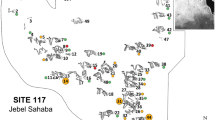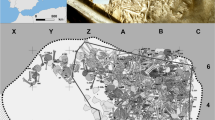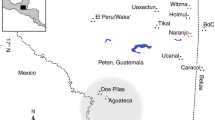Abstract
How did interpersonal violence develop in early human societies? Given that homicide records are only available for the more recent period, much of human history remains outside our purview. In this paper, we study violence trends in the very long run by exploiting a new dataset on cranial trauma and weapon-related wounds from skeletons excavated across the Middle East, spanning the pre-Classical period (around 12,000–400 bce). The dataset includes more than 3,500 individuals. We find evidence that interpersonal violence peaked during the Chalcolithic period (around 4,500–3,300 bce). It then steadily declined during the Early and Middle Bronze Ages (around 3,300–1,500 bce) and increased again between the Late Bronze and the Iron Age (1,500–400 bce). By documenting variations in violence patterns across a vast temporal and geographical scale in an incredibly rich historical setting, we broaden perspectives on the early history of human conflict.
This is a preview of subscription content, access via your institution
Access options
Access Nature and 54 other Nature Portfolio journals
Get Nature+, our best-value online-access subscription
$29.99 / 30 days
cancel any time
Subscribe to this journal
Receive 12 digital issues and online access to articles
$119.00 per year
only $9.92 per issue
Buy this article
- Purchase on Springer Link
- Instant access to full article PDF
Prices may be subject to local taxes which are calculated during checkout




Similar content being viewed by others
Data availability
The data that support the findings of this study are available in the publicly accessible Zenodo repository at https://doi.org/10.5281/zenodo.8010025 and in the Supplementary Data.
Code availability
Custom code that supports the findings of this study is available in the publicly accessible Zenodo repository at https://doi.org/10.5281/zenodo.8010025. The Stata code is also available in the Supplementary Code.
References
Pinker, S. The Better Angels of Our Nature: Why Violence Has Declined (Penguin Books, 2011).
Van Zanden, J. L. et al. How Was Life? Global Well-Being Since 1820 (OECD Publishing, 2014).
Eisner, M. From swords to words: does macro-level change in self-control predict long-term variation in levels of homicide? Crime Justice 43, 65–134 (2014).
Micale, M. & Dwyer, P. History, violence and Steven Pinker. Hist. Reflect. 44, 1–5 (2018).
Dwyer, P. & Micale, M. S. (eds) The Darker Angels of Our Nature: Refuting the Pinker Theory of History and Violence (Bloomsbury Academic, 2021).
Cirillo, P. & Taleb, N. N. On the statistical properties and tail risk of violent conflicts. Phys. Stat. Mech. Appl. 452, 29–45 (2016).
Harari, Y. N. Sapiens: A Brief History of Humankind (Harper Perennial, 2014).
LeBlanc, S. A. & Register, K. A. Constant Battles: Why We Fight (St. Martin’s Press, 2004).
Fibiger, L., Hudson, M. & Trundle, M. in The Cambridge World History of Violence Vol. I (eds Fagan, G. G. et al.) 19–36 (Cambridge Univ. Press, 2020).
Otterbein, K. F. The origins of war. Crit. Rev. 11, 251–277.
Otterbein, K. F. A history of research on warfare in anthropology. Am. Anthropol. 101, 794–805.
Hsiang, S. M., Burke, M. & Edward, M. Quantifying the influence of climate on human conflict. Science 341, 1235367 (2013).
Bartelink, E. et al. in Hunter-Gatherer Adaptation and Resilience: A Bioarchaeological Perspective (eds Stojanowski, C. M. & Temple, D. H.) 274–330 (Cambridge Univ. Press, 2018).
McCool, W. C., Vernon, K. B., Yaworsky, P. M. & Codding, B. F. Subsistence strategy mediates ecological drivers of human violence. PLoS ONE 17, e0268258 (2022).
McCool, W. C. et al. Climate change–induced population pressure drives high rates of lethal violence in the prehispanic Central Andes. Proc. Natl Acad. Sci. USA 119, e2117556119 (2022).
Bowles, S. Warriors, levelers and the role of conflict in human social evolution. Science 336, 876–879 (2012).
Kennett, D. et al. Drought-induced civil conflict among the Ancient Maya. Nat. Commun. 13, 3911 (2022).
Kohler, T. A., Ortman, S. G., Grundtisch, K. E., Fitzpatrick, C. M. & Cole, S. M. The better angels of their nature: declining violence through time among prehispanic farmers of the Pueblo Southwest. Am. Antiq. 79, 444–464 (2014).
Martin, D. L. & Harrod, R. P. Bioarchaeological contributions to the study of violence. Am. J. Phys. Anthr. 156, 116–145 (2015).
Steckel, R. H. & Rose, J. C. The Backbone of History: Health and Nutrition in the Western Hemisphere (Cambridge Univ. Press, 2002).
Steckel, R. H., Larsen, C., Roberts, C. & Baten, J. The Backbone of Europe: Health, Diet, Work and Violence over Two Millennia (Cambridge Univ. Press, 2018).
North, D. C., Wallis, J. J. & Weingast, B. R. Violence and Social Orders. A Conceptual Framework for Interpreting Recorded Human History (Cambridge Univ. Press, 2009).
Otterbein, K.F. How War Began (Texas A&M Univ. Press, 2004).
Dwyer, P. & Damousi, J. in The Cambridge World History of Violence Vol. I (eds Fagan, G. G. et al.) 1–18 (Cambridge Univ. Press, 2020).
Fibiger, L., Ahlström, T. & Smith, M. Conflict, violence and warfare among early farmers in Northwestern Europe. Proc. Natl Acad. Sci. USA 120, e2209481119 (2023).
McMahon, A. in Preludes to Urbanism. The Late Chalcolithic of Mesopotamia (eds Crawford, H. & McMahon, A.) 175–189 (McDonald Institute for Archaeological Research, 2014).
Cohen, H. et al. Trauma to the skull: a historical perspective from the Southern Levant (4300 bce–1917 ce). Int. J. Osteoarchaeol. 24, 722–736 (2012).
Sołtysiak, A. Antemortem cranial trauma in Ancient Mesopotamia. Int. J. Osteoarchaeol. 27, 119–128 (2015).
Rosenstock, E. et al. Human stature in the Near East and Europe ca. 10,000–1,000 bc: its spatiotemporal development in a Bayesian errors-in-variables model. Archaeol. Anthr. Sci. 11, 5657–5690 (2019).
Liverani, M. The Ancient Near East. History, Society, Economy (Routledge, 2014).
Riehl, S. in Encyclopaedia of the History of Science, Technology and Medicine in Non-Western Cultures (ed. Selin, H.) 1–15 (Springer, 2014).
Dow, G. K. & Reed, C. G. Economic Prehistory. Six Transitions that Shaped the World (Cambridge Univ. Press, 2023).
Algaze, G. Entropic cities. The paradox of urbanism in Ancient Mesopotamia. Curr. Anthropol. 59, 23–54 (2018).
Benati, G. in Urbanized Landscapes in Early Syro-Mesopotamia and Prehispanic Mesoamerica Papers of a Cross-Cultural Seminar held in Honor of Robert McCormick Adams (eds Marchetti, N. & Domenici, D.) 103–144 (Harrassowitz, 2018).
McMahon, A. Early urbanism in northern Mesopotamia. J. Archaeol. Res. 28, 289–337 (2020).
Frangipane, M. Different trajectories in state formation in Greater Mesopotamia: a view from Arslantepe (Turkey). J. Archaeol. Res. 26, 3–63 (2018).
Richardson, S. Early Mesopotamia: the presumptive state. Present 215, 3–49 (2012).
Richardson, S. in Ancient States and Infrastructural Power. Europe, Asia and America (eds Ando, C. & Richardson, S.) 17–62 (Univ. Pennsylvania Press, 2017).
Rey, S. in Focus on Fortification: New Research on Fortifications in the Ancient Mediterranean and the Near East (eds Frederiksen, R. et al.) 34–42 (Oxbow Books, 2016).
Heinz, M. in The Sumerian World (ed. Crawford, H.) 179–200 (Routledge, 2013).
Steinkeller, P. in The Oxford World History of Empire Vol. 2 (eds Bang, P. et al.) 43–72 (Oxford Univ. Press, 2020).
Barjamovic, G. in The Oxford World History of Empire Vol. 2 (eds Bang, P. et al.) 73–110 (Oxford Univ. Press, 2020).
Westbrook, R. (ed.) A History of Ancient Near Eastern Law (Brill, 2003).
Benati, G. & Guerriero, C. The origins of the state: technology, cooperation and institutions. J. Institutional Econ. 18, 29–43 (2022).
Matthews, R. J. & Richardson, A. Cultic resilience and inter-city engagement at the dawn of urban history: protohistoric Mesopotamia and the ‘city seals’, 3200–2750 bc. World Archaeol. 50, 723–747 (2018).
Sallaberger, W. Festival provisions in Early Bronze Age Mesopotamia. Kaskal 15, 171–200 (2018).
Steinkeller, P. in Labor in the Ancient World: A Colloquium held at Hirschbach (Saxony), April 2005 (eds Steinkeller, P. & Hudson, M.) 1–35 (ISLET-Verlag, 2015).
Benati, G. & Guerriero, C. The Origins of Culture https://doi.org/10.2139/ssrn.4181876 (SSRN, 2022).
Everest-Philips, M. in Public Service Excellence in the 21st Century (eds Baimenov, A. & Liverakos, P.) 53–104 (Palgrave Macmillan, 2019).
Ur, J. in The Sumerian World (ed. Crawford, H.) 131–155 (Routledge, 2013).
Cookson, E., Hill, D. J. & Lawrence, D. Impacts of long term climate change during the collapse of the Akkadian Empire. J. Archaeol. Sci. 106, 1–9 (2019).
Garfinkle, S. in The Cambridge World History of Violence (eds Fagan, G. G. et al.) 219–237 (Cambridge Univ. Press, 2020).
Benati, G. in The Earliest Economic Growth in World History: Proceedings of the Berlin Workshop (ed. Warburton, D.) 57–73 (Peeters, 2022).
Massa, M. & Palmisano, A. Change and continuity in the long-distance exchange networks between Western/Central Anatolia, Northern Levant and Northern Mesopotamia, c. 3200–1600 bce. J. Anthr. Archaeol. 49, 65–87 (2018).
Benati, G., Guerriero, C. & Zaina, F. The economic and institutional determinants of trade expansion in Bronze Age Greater Mesopotamia. J. Archaeol. Sci. 131, 105398 (2021).
Yoffee, N. & Barjamovic, G. in Grenzüberschreitungen. Studien zur Kulturgeschichte des Alten Orients. Festschrift für Hans Neumann anlässich seines 65. Geburtstages am 9. Mai 2018 (eds Paulus, S. et al.) 815–824 (Zaphon, 2018).
Pustovoytov, K. & Riehl, S. The Early Bronze Age/Middle Bronze Age transition and the aquifer geography in the Near East. J. Archaeol. Sci. 69, 1–11 (2016).
Bogaard, A., Fochesato, M. & Bowles, S. The farming-inequality nexus: new methods and evidence from Western Eurasia. Antiquity 93, 1129–1143 (2019).
Basri, P. & Lawrence, D. Wealth inequality in the Ancient Near East: a preliminary assessment using Gini coefficients and household size. Camb. Archaeol. J. 30, 689–704 (2020).
Adams, R. Mc. C. Old Babylonian networks of urban notables. Cuneif. Digit. Libr. J. 7, 1–14 (2009).
Charpin, D. in Mesopotamien: Die altbabylonische Zeit (eds Charpin, D. et al.) 25–480 (Academic Press-Vandenhoeck & Ruprecht, 2004).
Richardson, S. in Recent Directions in the Military History of the Ancient World (eds Bryce, T. & Roberts, J.) 11–51 (Regina Books, 2011).
Cline, E. H. 1177 B.C. The Year Civilization Collapsed (Princeton Univ. Press, 2014).
Kaniewski, D. 300-year drought frames Late Bronze Age to Early Iron Age transition in the Near East: new palaeoecological data from Cyprus and Syria. Reg. Environ. Change 19, 2287–2297 (2019).
Manning, S. W., Kocik, C., Lorentzen, B. & Sparks, J. P. Severe multi-year drought coincident with Hittite collapse around 1198–1196 bc. Nature 614, 719–724 (2023).
Wilkinson, T. J. Regional approaches to Mesopotamian archaeology: the contribution of archaeological surveys. J. Archaeol. Res. 8, 219–267 (2000).
Morris, I. The evolution of war. Cliodynamics 3, 9–37 (2012).
Turchin, P., Currie, T. E. & Turner, E. A. L. Mapping the spread of mounted warfare. Cliodynamics 7, 217–227 (2016).
Turchin, P. et al. Rise of the war machines: charting the evolution of military technologies from the Neolithic to the Industrial Revolution. PLoS ONE 16, e0258161 (2021).
Nadali, D. in The Other Face of the Battle. The Impact of War on Civilians in the Ancient Near East (eds Nadali, D. & Vidal, J.) 101–112 (Ugarit Verlag, 2014).
McGinnis, J. in The Other Face of the Battle. The Impact of War on Civilians in the Ancient Near East (eds Nadali, D. & Vidal, J.) 113–126 (Ugarit Verlag, 2014).
Squitieri, A. & Altawell, M. Empires and the acceleration of wealth inequality in the Pre-Islamic Near East: an archaeological approach. Archaeol. Anthropol. Sci. 14, 190 (2022).
Melville, S. C. in Brill’s Companion to Insurgency and Terrorism in the Ancient Mediterranean (eds Howe, T. & Brice, L. L.) 62–92 (Brill, 2016).
Stein, G. J. The development of indigenous social complexity in Late Chalcolithic Upper Mesopotamia in the 5th–4th millennia BC—an initial assessment. Origini 34, 125–151 (2012).
Sinha, A. et al. Role of climate in the rise and fall of the Neo-Assyrian Empire. Sci. Adv. 5, eaax6656 (2019).
Palmisano, A. et al. Holocene regional population dynamics and climatic trends in the Near East: a first comparison using archaeo-demographic proxies. Quat. Sci. Rev. 252, 106739 (2021).
Sołtysiak, A. & Fernandes, R. Much ado about nothing: assessing the impact of the 4.2 kya event on human subsistence patterns in Northern Mesopotamia using stable isotope analysis. Antiquity 95, 1145–1160 (2021).
Baten, J. & Steckel, R. H. in The Backbone of Europe (eds Steckel, R. H. et al.) 300–324 (Cambridge Univ. Press, 2018).
Garfinkle, S. in The Oxford Handbook of the State in the Ancient Near East and Mediterranean (eds Bang, P. & Scheidel, W.) 94–119 (Oxford Univ. Press, 2013).
Benati, G., Guerriero, C. & Zaina, F. The origins of political institutions and property rights. J. Comp. Econ. 50, 946–968 (2022).
Barjamovic, G. et al. Trade, merchants and the lost cities of the Bronze Age. Q. J. Econ. 134, 1455–1503 (2019).
Veldhuis, N. in The Oxford Handbook of Cuneiform Culture (eds Radner, K. & Robson, E.) 68–90 (Oxford Univ. Press, 2011).
Scheidel, W. The Great Leveler. Violence and the History of Inequality from the Stone Age to the Twenty-First Century (Princeton Univ. Press, 2017).
Wedel, V. L. & Galloway, A. Broken Bones. Anthropological Analysis of Blunt Force Trauma (Thomas Books, 2014).
Klimscha, F. Remarks on the technical development of bladed close combat-weapons and the use of the earliest swords. Reconsidering a late 4th/ early 3rd millennium find from Megiddo, Israel. Eurasia Antiq. 20, 219–228 (2014).
Frangipane, M. in Appropriating Innovations. Entangled Knowledge in Eurasia, 5000–1500 bce (eds Stockhammer, P. & Maran, J.) 171–183 (Oxbow Books, 2017).
Peltenburg, E. Conflict and exclusivity in Early Bronze Age societies of the Middle Euphrates Valley. J. East Stud. 72, 233–252 (2013).
Selover, S. L. Excavating War: The Archaeology of Conflict in Early Chalcolithic to Early Bronze III Central and Southeastern Anatolia. PhD thesis, Univ. of Chicago (2015).
Helwing, B. in (Re-)Constructing Funerary Rituals in the Ancient Near East (eds Pfälzne, P. et al.) 47–58 (Harrassowitz, 2012).
Stork, L. Systems of value and the changing perception of metal commodities, ca. 4000–2600 bc. J. East Stud. 74, 115–132 (2015).
Gernez, G. Les Armes Du Proche-Orient Ancien. Des Origines à 2000 Av. J.-C. (Errance, 2017).
Gernez, G. L’Armement en Métal au Proche et Moyen-Orient: des Origines à 1750 av. J.-C. PhD thesis, Univ. Panthéon-Sorbonne (2007).
Koubi, V. Climate change and conflict. Annu. Rev. Polit. Sci. 22, 343–360 (2019).
Staubwasser, M. & Weiss, H. Holocene climate and cultural evolution in Late Prehistoric–Early Historic West Asia. Quat. Int. 66, 372–387 (2006).
Weiss, H. in Megadrought and Collapse. From Early Agriculture to Angkor (ed. Weiss, H.) 93–160 (Oxford Univ. Press, 2017).
Benati, G. & Guerriero, C. Climate change and state evolution. Proc. Natl Acad. Sci. USA 118, e2020893118 (2021).
Boix, C. Political Order and Inequality: Their Foundations and Their Consequences for Human Welfare (Cambridge Univ. Press, 2015).
Ryan, W. B. F. et al. Global multi-resolution topography (GMRT) synthesis data set. Geochem. Geophys. Geosyst. 10, Q03014 (2009).
Acknowledgements
We thank A. Canci, W. Pestle, J. N. Postgate, E. M. Luby, G. Gernez and J. Nassar for having shared with us relevant published and unpublished materials and J. Anstett, G. Chignoli, B. Jung, S. Litzenberger, J. Seebacher and M. Stoppel for valuable research assistance. We acknowledge funding from the Deutsche Forschungsgemeinschaft (DFG, German Research Foundation), Collaborative Research Centre ResourceCultures—SFB 1070/3—Project number 215859406 (J.B. and G.B.) and from the Maria Zambrano 2021 programme (G.B.). The funders had no role in study design, data collection and analysis, decision to publish or preparation of the manuscript.
Author information
Authors and Affiliations
Contributions
J.B. and G.B. conceptualized this work. J.B., G.B. and A.S. developed the methodology. J.B., G.B. and A.S. undertook the investigations. J.B. and G.B. prepared the visualizations. J.B. acquired funding and carried out the project administration. G.B. wrote the original draft. J.B. and A.S. reviewed and edited the final manuscript.
Corresponding author
Ethics declarations
Competing interests
The authors declare no competing interests.
Peer review
Peer review information
Nature Human Behaviour thanks Andrea Dolfini, Linda Fibigier, Pauline Grosjean, Roger Matthews, Scott Ortman and the other, anonymous, reviewer(s) for their contribution to the peer review of this work. Peer reviewer reports are available.
Additional information
Publisher’s note Springer Nature remains neutral with regard to jurisdictional claims in published maps and institutional affiliations.
Supplementary information
Supplementary Information
Supplementary Methods, robustness and sensitivity tests, literature review and Appendixes A–C.
Supplementary Data
Research data.
Supplementary Code
Stata do file.
Supplementary Tables
Supplementary Tables 1–6.
Rights and permissions
Springer Nature or its licensor (e.g. a society or other partner) holds exclusive rights to this article under a publishing agreement with the author(s) or other rightsholder(s); author self-archiving of the accepted manuscript version of this article is solely governed by the terms of such publishing agreement and applicable law.
About this article
Cite this article
Baten, J., Benati, G. & Sołtysiak, A. Violence trends in the ancient Middle East between 12,000 and 400 bce. Nat Hum Behav 7, 2064–2073 (2023). https://doi.org/10.1038/s41562-023-01700-y
Received:
Accepted:
Published:
Issue Date:
DOI: https://doi.org/10.1038/s41562-023-01700-y



